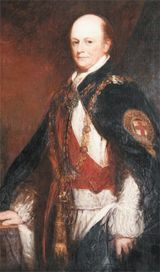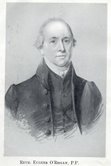The Hamilton Affair 1848-9
The Hamilton Affair 1848-9

Of the landed estates in Navan,
the affairs of the
Russell Estate,
owned by the
Duke of Bedford,
are most interesting
in that it saw the
most dramatic changes
in the mid 1800's
and gives a unique insight
into the workings of the
system at tht time.
Pictured left is
Francis Russell
7th Duke of Bedford
1788-1861
The area in question (around Brews Hill) covered ten acres. It was leased by Ludlow to a Mr Barry in 1774 for
three lives.
At that time the only buildings on the land were four slated houses and seven cabins. This lease expired in 1839 and Rev. Hamilton became the new tenant for 30 years at a rent of £43 a year.
Hamilton failed to control building and sub division on the land so that by 1848 he had 34 yearly tenants who had a further 47 sub tenants.
The inhabitants of the area were mainly supported by the Poor Law and the indignation of the town's businessmen and landowners grew at the squalor of that end of the town and the behaviour of its inhabitants.
The Duke of Bedford had a survey of the area carried out in 1848 and it was decided to relieve Hamilton of his lease. Hamilton sought £1,300 compensation, later reduced to £1,000, but the landlord refused and pointed to the valuation made of the area under the direction of the Poor Law Guardians. This stated that 30 of the cabins had an annual value of £33. They had a valuation from 10 shillings to £2 each. The valuer said that the rest of the cabins were valueless. Hamilton was eventually dispossessed before the Assizes of Meath in July 1848, and plans were drawn up for the improvement of the area and other estate property in the town.
After further surveys and discussions in February 1849 various improvements were suggested. The first suggestion involved the removal of all cabins on the plot and compensation to the tenants thereby enabling them to migrate or to transfer them to some other part of the town.
Joly, the local estate agent, also proposed that a market house be built for the town since;
'it is a town of very considerable traffic and there has never been the least encouragement- that is no Market House or other suitable accomodation for the trader.'
The first proposal was
 acted upon leading to the eviction of a great number of people.
acted upon leading to the eviction of a great number of people. Fr. O' Reilly, the parish priest (pictured left) protested strongly:
"One hundred dwellings and the occupants beyond six hundred in number were left houseless and a boundary wall was built on the site of some of those houses instead of new dwellings of a better description as we were led to believe would be the case."
This clearance obviously meant a tremendous upheaval with 120 households made homeless in a matter of weeks. Many settled on the Fair Green. Soon after, all the cabins in this area were indiscriminately demolished, although some settlers had squatters rights being under no obligation to pay rent to the Corporation which had allowed them to settle the area... These clearances and the ensuing disputes pinpoint the nature of the claims and counter claims of all parties involved in this type of situation. The estate agent, for example, claimed that the Brews Hill area had been a "receptacle of villainy and nursery of crime and disease."
This clearance obviously meant a tremendous upheaval with 120 households made homeless in a matter of weeks. Many settled on the Fair Green. Soon after, all the cabins in this area were indiscriminately demolished, although some settlers had squatters rights being under no obligation to pay rent to the Corporation which had allowed them to settle the area... These clearances and the ensuing disputes pinpoint the nature of the claims and counter claims of all parties involved in this type of situation. The estate agent, for example, claimed that the Brews Hill area had been a "receptacle of villainy and nursery of crime and disease."
But Fr. O'Reilly denied this and vouched for the morality of 60 of the 80 tenants. He admitted the problems brought on by sub letting but claimed that these "lodgers were nearly all simple country people. They were persecuted by the Landlord Guardians, driven from their houses by them, and because your Grace's tenants observed the Laws of the Gospel in giving them shelter, they in turn were indiscriminately denounced to your Grace as a congregation of robbers'.
The letter ends with a very pertinent point 'if other noblemen should follow your Grace's example, Navan would cease to be a town."
In fact better class houses were built on the site of the old cabins in Brews Hill and Chapel Lane which is now Railway Street, although former tenants were not necessarily reinstated.
The whole 'Hamilton Affair' is important in several respects. Most obviously, Hamilton's mismanagement induced a clinging together of people at a particulary critical time which was followed by a ruthless clearing of the landscape. The processes and forces manifested in this important episode in Navan's history are the factors of change most potent in shaping new landscapes and human population.
The whole 'Hamilton Affair' is important in several respects. Most obviously, Hamilton's mismanagement induced a clinging together of people at a particulary critical time which was followed by a ruthless clearing of the landscape. The processes and forces manifested in this important episode in Navan's history are the factors of change most potent in shaping new landscapes and human population.
These factors were:
Hamiliton's initial mismanagement and the terrible conquences it produced. The public outcry and more specifically the outcry of those paying high rates at the presence of the immoral masses inhabiting the area signifying a crystallisation of class divisions in Navan at a time of crisis. The estate agent's central role in the landlord's information system;
Fr. O'Reilly's controlled outburst reflecting the growing significance of the Catholic Church.
These, one may define as important parameters of change, all helping to shape new forms.
These, one may define as important parameters of change, all helping to shape new forms.
Source: An Economic Geography of County Meath 1770 -1870, Peter Connell